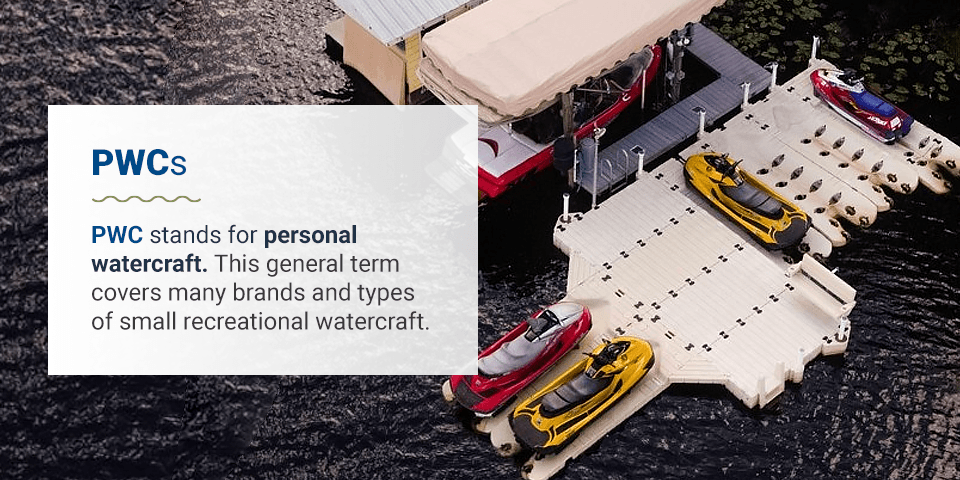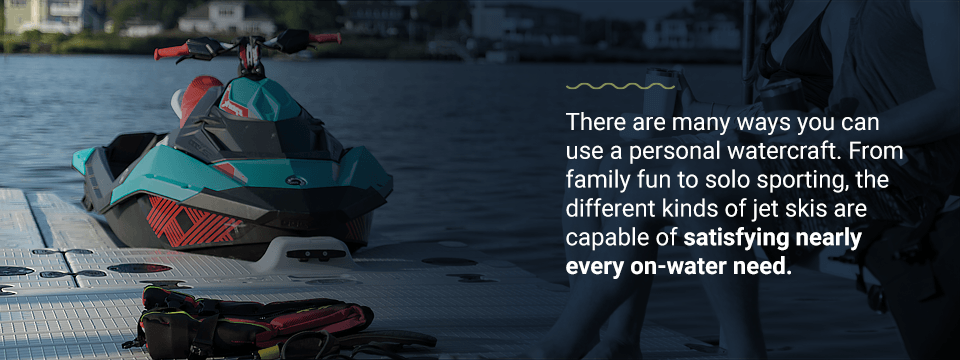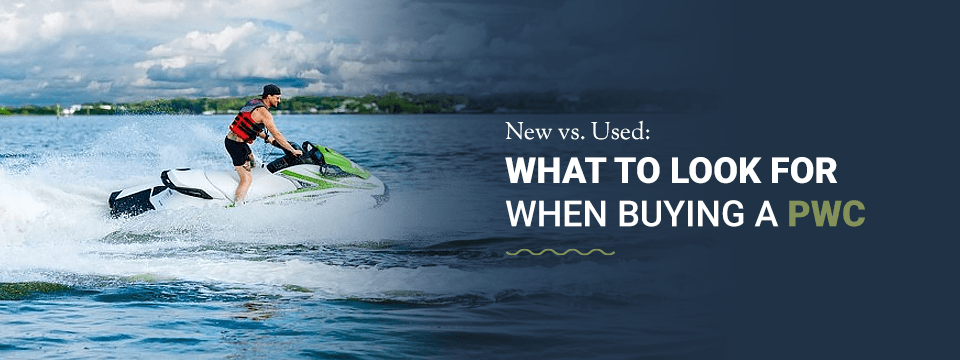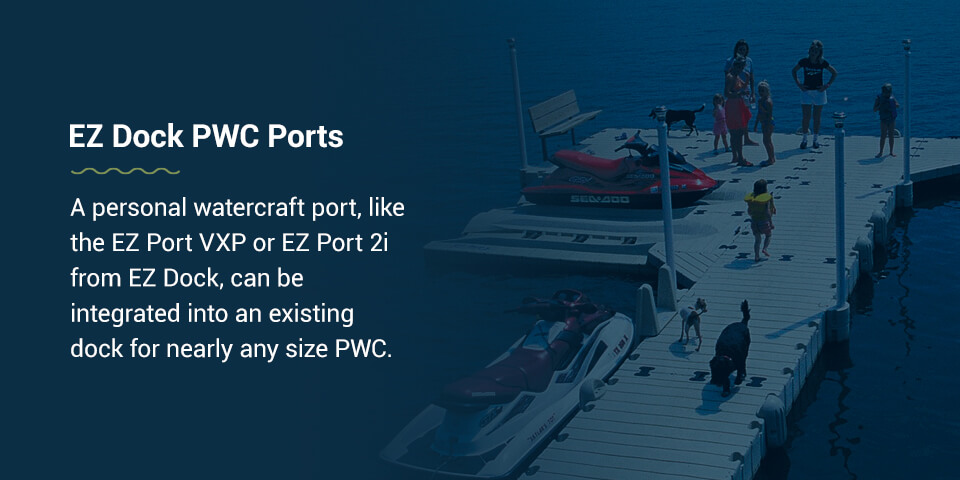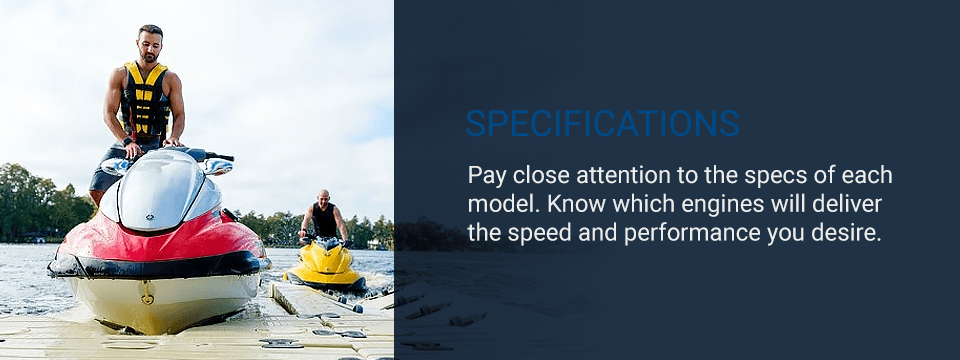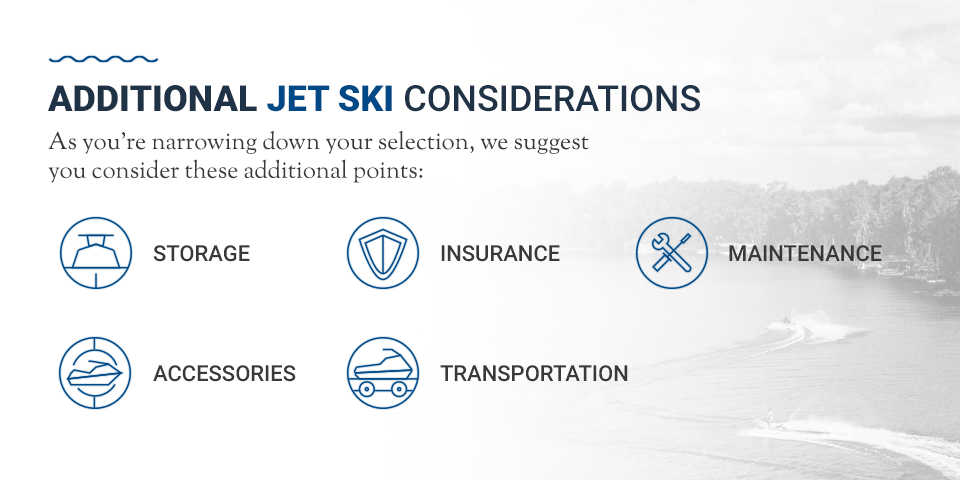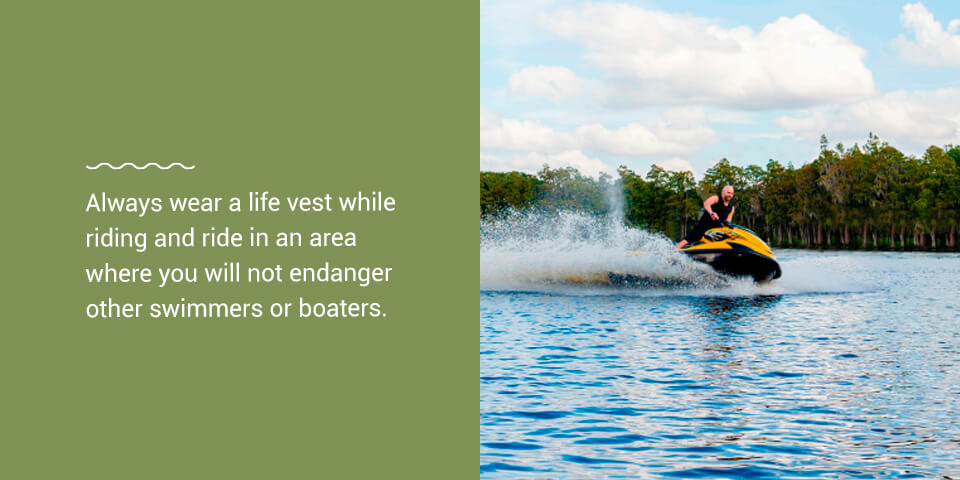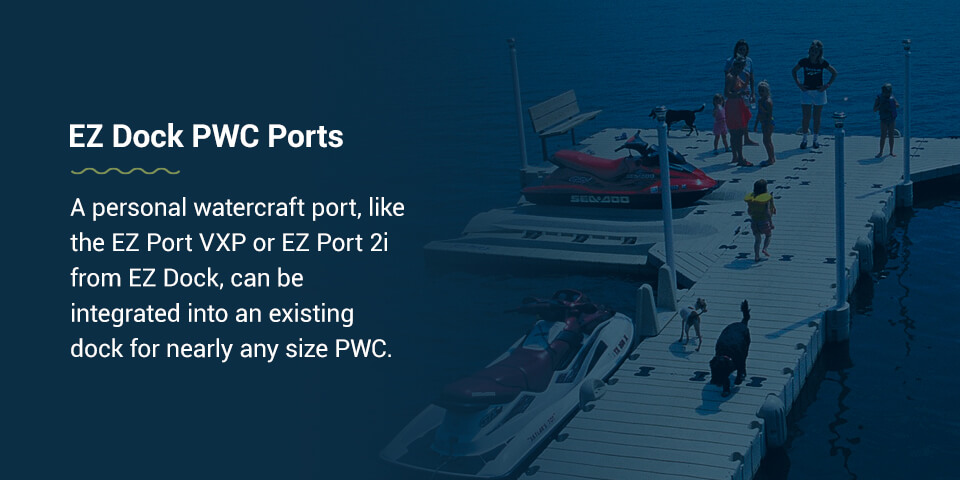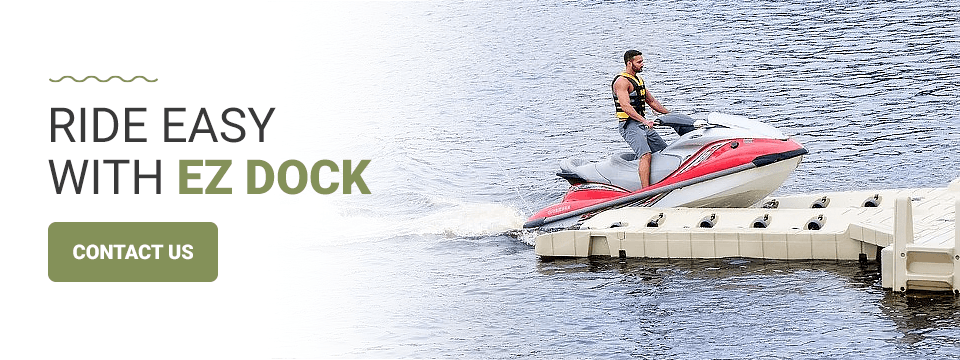Filters
PWC Buying Guide: Jet Skis, WaveRunners & More
At EZ Dock, we know that there’s no better feeling than jetting across the water, catching waves on a personal watercraft. As a trusted provider of custom waterfront docking solutions for PWCs, we also know that no two WaveRunners, Jet Skis, or Sea-Doos are the same. To help point you in the right direction, we’ve created this handy PWC buying guide to help you determine what to buy based on your needs and provide tips on caring for your PWC.
Read the full article or jump to a specific section:
- The Different Types of Personal Watercraft
- The Many Uses of Jet Skis, Sea-Doos & WaveRunners
- Freshwater vs. Saltwater Jet-Skiing
- New vs. Used: What to Look for When Buying a Jet Ski or Other PWC
- Three benefits of buying a new Jet Ski, Sea-Doo or WaveRunner
- Three benefits of buying a used Jet Ski, Sea-Doo or WaveRunner
- What to Look for in a Used Jet Ski, WaveRunner or Sea-Dooat
- Additional PWC Purchasing Considerations
- Beginner Jet Skier Tips, Tricks and Advice
- Ride Easy with EZ Dock
The Different Types of Personal Watercraft
Personal watercrafts are often referred to by many names:
- PWC’s: PWC stands for personal watercraft. This general term covers many brands and types of small recreational watercraft. A rider sits or stands on this vehicle rather than inside it as on a standard boat. PWC’s are sometimes also called “water scooters” but are mostly known by the brand names of the three biggest manufacturers: Jet Skis, WaveRunners and Sea-Doos.
- Jet Skis: The term Jet Ski comes from the brand name of personal watercraft manufactured by Kawasaki. Their offerings include over a dozen stand up, three-passenger and supercharged models.
- WaveRunners: The phrase WaveRunner is the brand name of a PWC manufactured by Yamaha. They currently offer four different series of WaveRunners composed of 18 different models. Models in their line have received numerous Watercraft of the Year awards.
- Sea-Doos: A Sea-Doo is another brand name of personal watercraft. Their products have received Red Dot Design Awards and include six different models.
Whether you know these recreational vehicles by brand name or general terminology, a PWC is a vessel that uses an inboard motor for propulsion via a water jet pump. They can be operated by standing, sitting or kneeling and can be used in fresh or saltwater environments. Depending on the model and manufacturer, each PWC offers specific advantages or benefits that help you achieve your desired ride.
Apart from the manufacturer, personal watercraft can be broken down into additional subcategories that take into account the position of the rider, the number of passengers and the type of water ridden in.
- Stand-up PWCs: The original type of PWC, stand-up PWCs are smaller, making them easier to transport. They also require less maintenance compared to larger, more complex PWCs. Stand up watercraft usually fit a single rider and are often geared toward more active use, like doing tricks and racing.
- Sit-down PWCs: Sit-down PWCs are larger than stand-up versions to accommodate a more comfortable ride. They can typically fit more than a single rider and can tow objects like rafts or wakeboarders. The performance of sit-down PWCs will vary from smooth cruising models to faster, more performance-driven models. These can accommodate up to four riders depending on the model.
Each of these PWC variations is meaningful for the vessel’s design as well as its performance. For instance, some multi-seater models may be geared towards comfort and stability, while other PWC models may be built for speed and solo rider performance. Knowing how you’ll use your watercraft should influence your final decision.
No matter which version you choose, our dock systems are compatible with all major brands and variations.
The Many Uses of Jet Skis, Sea-Doos & WaveRunners
There are many ways you can use a personal watercraft. From family fun to solo sporting, the different kinds of Jet Skis, WaveRunners, and Sea-Doos can satisfy nearly every on-water need.
As you learn about the different types of PWC, consider the ways you’ll most likely use this vessel:
- Learning the ropes as a beginner: Every rider needs to start somewhere. The standard PWC model is the perfect personal watercraft for a first-time PWC buyer to test the waters, literally and figuratively.
- Providing fun for the family: One of the best reasons to own a PWC like a Jet Ski is that you can have fun sharing it with the whole family. You might want to consider sit-down, smooth-riding models for family fun.
- Action and adventure: Let’s face it — many people who hop on a Jet Ski or other PWC want an adrenaline-fueled ride. High-performance Jet Skis, WaveRunners and Sea-Doos deliver just that.
- A perfect-sized fishing vessel: PWCs are versatile watercraft ideal for aquatic adventures of all sorts. Their small size enables them to navigate narrow channels and shallow waters that some boats cannot reach, making them perfect tools for fishing.
- Emergency rescue services: Of course, many lifeguard stations on beaches have PWCs on standby should they need to use them to quickly rescue a swimmer or boater farther from shore.
- Law enforcement services: PWCs are a valuable resource for law enforcement officials to patrol waterways, rescue civilians and respond to calls during on-water incidents.
Though you’ve surely witnessed a WaveRunner or Sea-Doo cruising past the ocean coastline, you can use PWCs in nearly every other body of water, including lakes, ponds and rivers. However, not all water types are the same, and it’s essential that you understand how saltwater can impact your PWC.
Freshwater vs. Saltwater Jet-Skiing
Any time spent on the water is time well spent. While boating is a fun way to enjoy life topside, riding around on a PWC is a unique open water experience that can’t be compared to any other aquatic activity. If you’re lucky enough to own a PWC in a region where you have access to the ocean, lakes, rivers and canals, you’ll be thrilled to know that you can enjoy your PWC in all of these waters.
Where you plan to go Jet-Skiing is an essential factor in your purchasing choice. Some people may not realize that even though they bought the best option for the ocean, they still need to take precautions. Saltwater can cause damage to your PWC. Even the backwaters near the sea may have a high salt content that can corrode your vessel. You’ll need to consistently care for your PWC any time you use it in these environments.
Thorough cleaning is vital after a ride in saltwater. First, you should flush the water injection port with fresh, clean water. This water will run through the interior of your system and flush out lingering saltwater. You may also want to use a salt dissolver to ensure that even the smallest salt particles are removed. Carefully rinse out the engine bay to clear any traces of salt water, being especially careful not to get the electrical components wet.
You also must properly take care of the exterior, as saltwater can harm other components of the WaveRunner, Sea-Doo or Jet Ski such as the seats, coverings and hull. Rise and wipe the entire PWC down and hand-wash areas like the seat crevices that rinsing may not fully cover. After a saltwater run, you can prevent costly damages and a potentially shortened lifespan by taking care of your vehicle.
New vs. Used: What to Look for When Buying a Jet Ski or Other PWC
The thought of finally owning your own personal watercraft is exciting, and you’ll be tempted to get out on the open water as quickly as possible after you’ve made up your mind. However, buying a PWC is a significant purchase, and you should prepare to buy a Jet Ski in the same way as planning a car, motorcycle or boat purchase. Before you make a final decision — or even begin your search — you should be able to answer the following questions:
- Why do you want a PWC? Riding on a PWC is a fantastic feeling, and owning one is even more fun! Whether it’s for occasional recreation when the summer arrives or for fishing every weekend, you should know why exactly you’re buying one.
- Size and functionality: You should choose a size that caters to who will use your PWC and how you want to use it. For instance, PWCs for solo riders are smaller, more agile and geared toward riders with more experience. Larger models can accommodate up to four passengers, offer better stability and can tow rafts or wakeboarders.
- Can you already ride a PWC? You don’t need to know how to ride a PWC before purchasing one, but it would be beneficial to learn before getting your own.
- Where will you use it? Lakes, rivers, oceans and even canals are great spots to use your PWC. Know where you can legally and safely operate your PWC around your home.
- How often will you use it? If you have waterfront property or public boating areas close by, you may be using your Jet Ski, Sea-Doo, or WaveRunner more frequently than if you have to drive hours to reach a body of water. Be sure to keep in mind the seasonal changes in your region that impact your ability to use a PWC.
- Who else will use it? If friends and family are also riding, you’ll want to take this into account to help you pick out a PWC that suits the needs of children or more inexperienced Jet Skiers.
- What is your budget? You should have a set budget in mind before you browse so you can responsibly afford this investment for the long term.
- Is there a model or brand you are focused on? Every brand and model of personal watercraft has advantages and drawbacks that may cater to or limit your plans for using it. Thoroughly research brands or models and read user reviews before making the final purchase to help make sure you’re getting the right PWC for your needs. Pay close attention to the specs of each model. Know which engines will deliver the speed and performance you desire. Compare aspects like stroke type, aspiration and fuel consumption.
- Will you buy a new or used PWC? This is a critical question and requires a lot of thought. While newer PWCs are pricier, they can come with warranties that provide peace of mind. Often, there’s nothing wrong with buying a used Jet Ski, Sea-Doo, or WaveRunner as long as you thoroughly inspect the PWC for potential flaws and maintenance needs before purchasing.
Consider choosing a PWC in the same way you would select a car. You can have the newest model for a higher price, or you can spend less money and pick a pre-owned model that other outdoor enthusiasts have enjoyed. There is no wrong choice — just simply the best choice for your needs, lifestyle and budget.
Buying a New PWC
Buying a new PWC is an investment, as new Jet Skis cost more than buying used. However, buying new comes with several benefits, including:
- You won’t have to worry about hours of wear and tear from previous owners.
- The newest models often feature the latest improvements in everything from performance to technology.
- Many new PWCs come with warranties.
There are several things to look for when buying a Jet Ski:
- Managing Jet Ski distributors: Jet Ski distributors are a lot more casual than car distributors, and there’s typically a lot less associated paperwork. You should still ensure you record all interactions and transactions in writing. Email is a good way to record conversations and negotiations, and you should always have a distributor record the deal on their letterhead.
- When to buy: Knowing when to buy a new Jet Ski can save you a lot of money. Like many other products, it’s best to buy PWCs during the off-season. You’ll get the best deals if you buy at the end of summer when distributors announce the next year’s models and discount the current stock. It’s also good to buy at the end of the month, as distributors are trying to meet manufacturer-imposed sales quotas.
- Associated fees: Consider associated costs when planning your budget. While cars are shipped to distributors ready to go, distributors must pay someone to get Jet Skis out of crates. Further, some manufacturers don’t include the battery with the PWC, causing even more fees. Distributors must also assemble PWCs, pay for freight and pay documentation costs, resulting in even higher prices.
- Test drives: A test drive is crucial when buying any vehicle. Many distributors aren’t on a waterfront, which can make a test drive difficult. To remedy this problem, some distributors have demo models you can take for a test ride. However, distributors might not have a demo for every model, so you may have to visit several distributors to find the model you’d like to test drive. You can also contact a rental service to try out a PWC without committing to a purchase.
- Delivery: Once you purchase your PWC, you’ll have to consider how to transport it from the distributor. If you don’t have a trailer for safe transport, you should ask the distributor whether they offer delivery services.
Buying a Used PWC
Shopping for a Jet Ski or other PWC involves a lot of research and many considerations, especially if you choose to buy a pre-owned PWC. Buying a PWC isn’t as simple as picking the coolest watercraftdel out of the lineup and heading to the water. Keep these eight points in mind as you look for the best used PWC:
- Hours: Knowing the average lifespan of a WaveRunner, Jet Ski or Sea-Doo is helpful. Typically, most PWCs will perform optimally for an average of 300 hours. Below 50 hours is considered low usage, while above 150 is deemed to be high. Take hour usage into account when you assess the condition of a model.
- Maintenance records: Poor maintenance practices can wreak havoc regardless of how many hours previous owners have used a PWC. Ask how many prior users have owned it and if the PWC comes with ownership, maintenance or repair records.
- Wear and tear: Anything that you purchase pre-owned is bound to have some form of wear and tear. First, inspect the PWCs exterior. Look for scratches and dents along the body, then move on to the seat, handles and controls to discover potential damage. Next, perform a more thorough inspection, looking for rust or weather damage. Ask how it was stored — sitting in the water, sun or an uncovered space can potentially increase the likelihood of idle damage.
- Test drive: Would you buy a car without test driving it? Of course, you wouldn’t, which is why you should take any opportunity to test out the PWC as soon as possible. Ideally, the distributor or private owner that you’re purchasing it from will be able to accommodate a test run. If not, you should get your Jet Ski in the water as quickly as possible. Try to find a vendor that offers a return window should you discover a mechanical or performance issue soon after your purchase.
- Mechanic checks: Another way you can discover any hidden problems with your used Jet Ski is to take it to a mechanic specializing in personal watercraft. They’ll know which areas to inspect to ensure that your PWC is ready for the water.
- Warranties: If possible, purchase a WaveRunner, Jet Ski or Sea-Doo that is either still under manufacturer warranty or that comes with a limited warranty from the distributor. This coverage can protect you should a problem arise soon after your purchase.
Three benefits of buying a used Jet Ski, Sea-Doo or WaveRunner include:
- Typically, a pre-owned PWC will be less expensive than a new one.
If you plan on owning multiple PWCs, purchasing a used model first will allow you to become a better rider and learn maintenance before investing in a brand new model.
A used Jet Ski or PWC is still a significant investment, but opting to purchase a pre-owned model allows you to get used to the financial responsibilities associated with maintenance, insurance and other necessary costs.
What to Look for in a Used Jet Ski, WaveRunner or Sea-Doo
Shopping for a Jet Ski or other PWC involves a lot of research, and you need to make many considerations, especially if you choose to buy a pre-owned PWC. Buying a PWC isn’t as simple as picking the coolest looking model out of the lineup and heading to the water. Keep these eight points in mind as you look for the best used PWC:
- Size and functionality: Depending on who will use your PWC and how you want to use it, you may need to choose a size that caters to this functionality. For instance, PWC’s for solo riders are smaller, more agile and are geared toward riders with more experience. Larger models can accommodate up to four passengers, offer better stability and can tow rafts or wakeboarders.
- Hours: Knowing the average lifespan of a WaveRunner, Jet Ski or Sea-Doo is helpful. Typically, most PWC’s will perform optimally for an average of 300 hours. Below 50 hours is considered low usage while above 150 is considered high. Take hour usage into account when you assess the condition of a model.
- Specifications: You should also pay close attention to the specs of each model. Know which engines will deliver the speed and performance you desire. Compare aspects like stroke type, aspiration and fuel consumption.
- Maintenance records: Regardless of how many hours a PWC has been used, poor maintenance practices can wreak havoc. Ask how many previous users have owned it and if the PWC comes with ownership, maintenance or repair records.
- Wear and tear: Anything that you purchase pre-owned is bound to have some form of wear and tear. First, inspect the PWC’s exterior. Look for scratches and dents along the body then move on to the seat, handles and controls to discover what damage may be present. Next, perform a more thorough inspection, looking for rust or weather damage. Ask how it was stored — sitting in the water, sun or in an uncovered space can potentially increase the likelihood of idle damage.
- Test drive: Would you buy a car without test driving it? Of course, you wouldn’t, which is why you should take any opportunity to test out the PWC as soon as possible. Ideally, the dealer or private owner that you’re purchasing it from will be able to accommodate a test run. If not, you should get your Jet Ski in the water as quickly as possible. Try to find a vendor that offers a return window should you discover a mechanical or performance issue soon after your purchase.
- Mechanic checks: Another way you can discover if there are any hidden problems with your used Jet Ski is to take it to a mechanic that specializes in personal watercraft. They’ll know which areas to inspect to ensure that your PWC is ready for the water.
- Warranties: If possible, purchase a WaveRunner, Jet Ski or Sea-Doo that is either still under manufacturer warranty or that comes with a limited warranty from the dealer. This coverage can protect you should a problem arise soon after your purchase.
Additional PWC Purchasing Considerations
As you’re narrowing down your selection, we suggest you consider these additional points:
- Storage: Where are you keeping your PWC? If you’re keeping it at home, you’ll need a proper storage solution. Environmental damage can occur even out of the water, so you’ll want to keep it covered and secured in a garage, shed or storage unit. If you plan to store it on-site at your favorite recreation area, research the annual costs, if the establishment is insured and how often you can access your PWC.
- Transportation: Unless you live on waterfront property, you’ll need a reliable and safe way to transport your PWC. Look into trailers that will conveniently help you get your PWC between places without incurring any damage. If you’re storing it on-site at a recreation area, discover how their employees will transport it should it need to be moved or relocated to a different storage area.
- Insurance: You should seriously consider a separate PWC insurance policy, as most home and auto policies do not include this type of coverage. Many insurance companies offer plans that cover personal injuries, property damage, medical payments incurred from accidents and damage to your PWC. It may also protect you in situations where an uninsured watercraft operator caused an accident.
- Maintenance: New or used, you’ll eventually need to have your Jet Ski, Sea-Doo or WaveRunner repaired or serviced. Make sure you keep up on any requirements set by warranties and perform routine maintenance when necessary.
- Accessories: You can use a PWC immediately after purchasing it, but we suggest buying a few helpful accessories first. Pick up a few life jackets to keep riders safe. You should also consider buying covers to keep your PWC safe during transport and storage. If you want to use your watercraft for fishing or exploring, a marine GPS unit is a convenient resource to have on hand. Though not a necessity, a mountable camera like a GoPro lets you relive your ride onshore.
Beginner Jet Skier Tips, Tricks and Advice
Even if you’ve ridden on a Jet Ski, Sea-Doo or WaveRunner before, owning your own PWC is a much different experience. For those who are new to ownership — or simply riding a PWC at all — here’s some helpful advice:
- Safety first: Don’t operate a PWC while intoxicated. Always wear a life vest while riding and ride in an area where you will not endanger other swimmers or boaters. If another individual or child is riding the PWC or riding with you, make sure they are also engaging in smart safety practices.
- Learn from the pros: Whether you want to learn new tricks or strengthen your performance as a safe rider, professional lessons can help riders of all experience levels.
- Never neglect maintenance: Care for your PWC like you would any significant investment. Keep it clean and covered when not in use. Winterize it during the colder months, and make sure it’s washed and dried properly after leaving the water in the summer months. Perform routine maintenance checks and always address any areas of concern.
- Always check your fuel level: Never leave the shore without knowing your fuel level. One good practice is to fill up your tank every time you head home.
- Prepare for emergencies: An emergency can happen at any time. Keep a first aid kit, communication device and extra life jacket in your storage hull at all times.
EZ Dock PWC Ports
A personal watercraft port, like the EZ Port VXP or EZ Port 2i from EZ Dock, can be integrated into an existing dock for nearly any size PWC. Our ports are designed to be self-adjusting and can be used in fresh and saltwater. These devices enhance your convenience and safety by providing you with a stable structure that helps you get on and off of the Jet Ski after you’ve rolled it into the port. It also decreases the chances of the PWC becoming damaged by bumping into the dock.
Benefits of using EZ Dock PWC Ports include:
- Safe and easy access: Our ports are designed with a raised bow, so you’ll be less likely to overshoot the port with minimal effort, as the lift adjusts to water levels without cranking or hoisting, protecting your PWC from waves. Use the EZ Dock Bow Stop with the EZ Dock 2i port to further assist with safe porting your PWCs. They also have maximum space, so you can easily find your footing.
- Connect to other ports: Our EZ Port® coupler system lets you easily and stably connect ports to floating and fixed docks or one another. We offer flexible solutions for commercial and residential use, and our modular ports allow for unique docking configurations.
- Stability: Our ports have a buoyant proprietary flotation chamber and a pylon design for maximum stability, even in rough conditions. The polyethylene material is slip-resistant and will never rot nor need painted, lasting you for years. You can also clean them with a pressure washer.
- EZ Port Max System: If you have multiple PWCs, consider using the EZ Port Max System. The Max System connects to the entry section of the port and lets you configure your ports for your specific waterfront. Our Max Entry system is the base for all of our other port systems. It can be connected to different ports or used as a standalone unit.
Ride Easy With EZ Dock
Are you ready to jump on your PWC and ride some waves? Let us help make your experience awesome with our EZ Dock PWC docking solutions. Our EZ Ports for PWCs are the perfect tool to assist you in riding and caring for your Jet Ski, WaveRunner or Sea-Doo. Our newest EZ Port 280 offers multiple advantages that make it the ideal solution for any waterfront location. It enables you to get in and out of the port easily and keeps your PWC clean, secure and accessible. Contact us today or request a quote online for EZ Dock PWC ports.


